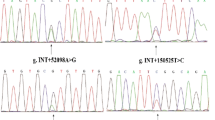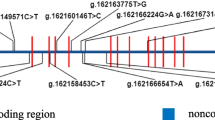Abstract
DLK1 and CLPG were located in DLK1-GTL2 imprinted cluster. They all affected muscle growth and meat tenderness. The functional importance of DLK1 and CLPG imply that the variation of the genes could affect the growth traits of animal. PCR-SSCP and sequencing were used to analyze the four loci of DLK1 gene and CLPG gene in 1109 individuals, which belong to eight breeds/species of bovidae, including cattle, buffalo and yak. A synonymous mutation (C451T) was detected in exon 5 of DLK1 in Qinchuan cattle, but didn’t change significantly with phenotypic traits. Three genotypes AA, AB and AC of CLPG were identified in Jiaxian cattle. The associations analyst of different genotypes showed that the individuals with genotypes AA and AC had a greater body weight and longer body length than those with genotype AB (P < 0.05 and P < 0.01, respectively); the AA individuals were different from those AB (P < 0.05) in the circumference of cannon bone. No polymorphism was observed in the other populations at other loci. These results were in agreement with the homology analysis: DLK1 and CLPG genes were in a highly conserved.


Similar content being viewed by others
References
Constância M, Kelsey G, Reik W (2004) Resourceful imprinting. Nature 432:53–57
Kaneko-Ishino T, Kohda T, Ono R, Ishino F (2006) Complementation hypothesis: the necessity of a monoallelic gene expression mechanism in mammalian development. Cytogenet Genome Res 113:24–30
Lewis A, Redrup L (2005) Genetic imprinting: conflict at the callipyge locus. Curr Biol 15:R291–R294
Edwards CA, Mungall AJ, Matthews L et al (2008) The evolution of the DLK1-DIO3 imprinted domain in mammals. PLoS Biol 6:1292–1305
Laborda J (2000) The role of the epidermal growth factor-like protein dlk in cell differentiation. Histol Histopathol 15:119–129
Carmen H, Carmen G, de Manuel O et al (2008) The serum levels of the EGF-like homeotic protein dlk1 correlate with different metabolic parameters in two hormonally different children populations in Spain. Clin Endocrinol 69:216–224
Weng T, Gao L, Bhaskaran M et al (2009) Pleiotrophin regulates lung epithelial cell proliferation and differentiation during fetal lung development via β-catenin and Dlk1. J Biol Chem 284:28021–28032
Temple IK, Shrubb V, Lever M, Bullman H, Mackay DJG (2007) Isolated imprinting mutation of the DLK1/GTL2 locus associated with a clinical presentation of maternal uniparental disomy of chromosome 14. J Med Genet 44:637–640
Samulin J, Berg PR, Sundvold H, Grindflek E, Lien S (2009) Expression of DLK1 splice variants during porcine adipocyte development in vitro and in vivo. Anim Genet 40:239–241
Matsuzawa Y, Tohru F, Tadashi N (1999) Molecular mechanism of metabolic syndrome X: contribution of adipocytokines adipocyte-derived bioactive substances. Ann NY Acad Sci 892:146–154
Vuocolo T, Pearson R, Campbell P, Tellam RL (2003) Differential expression of Dlk-1 in bovine adipose tissue depots. Comp Biochem Phys B 134:315–333
Moon YS, Smas CM, Lee K et al (2002) Mice lacking paternally expressed Pref-1/Dlk1 display growth retardation and accelerated adiposity. Mol Cell Biol 22:5585–5592
Davis E, Jensen CH, Schroder HD et al (2004) Ectopic expression of DLK1 protein in skeletal muscle of padumnal heterozygotes causes the callipyge phenotype. Curr Biol 14:1858–1862
Abdallah BM, Boissy P, Tan Q et al (2007) dlk1/FA1 regulates the function of human bone marrow mesenchymal stem cells by modulating gene expression of pro-inflammatory cytokines and immune response-related factors. J Biol Chem 282:7339–7351
Kim K-S, Kim J-J, Dekkers JCM, Rothschild MF (2004) Polar overdominant inheritance of a DLK1 polymorphism is associated with growth and fatness in pigs. Mamm Genome 15:552–559
Jonghyun S (2009) The role of chicken delta-like protein 1 expression in skeletal muscle development and regeneration. Doctoral Dissertation of the Ohio State University
Cockett NE, Jackson SP, Shay TL et al (1994) Chromosomal localization of the callipyge gene in sheep (Ovis aries) using bovine DNA markers. Proc Natl Acad USA 91:3019–3023
Abdulkhaliq AM, Meyer HH, Thompson JM et al (2002) Callipyge gene effects on lamb growth, carcass traits, muscle weights and meat characteristics. Small Rumin Res 45:89–93
Busboom JR, Wahl TI, Snowder GD (1999) Economics of callipyge lamb production. J Anim Sci 77:243–248
Charlier C, Segers K, Karim L et al (2001) The callipyge mutation enhances the expression of coregulated imprinted genes in cis without affecting their imprinting status. Nat Genet 27:367–369
Murphy SK, Freking BA, Smith TPL et al (2005) Abnormal postnatal maintenance of elevated DLK1 transcript levels in callipyge sheep. Mamm Genome 16:171–183
Li F, Chen H, Lei C et al (2010) Novel SNPs of the bovine NUCB2 gene and their association with growth traits in three native Chinese cattle breeds. Mol Biol Rep 37:541–546
Ren G, Chen H, Zhang L et al (2010) A coding SNP of LHX4 gene is associated with body weight and body length in bovine. Mol Biol Rep 37:417–422
Zhang B, Chen H, Guo Y et al (2009) Associations of polymorphism within the GHSR gene with growth traits in Nanyang cattle. Mol Biol Rep 36:2259–2263
Liu H, Tian W, Zan L, Wang H, Cui H (2010) Mutations of MC4R gene and its association with economic traits in Qinchuan cattle. Mol Biol Rep 37:535–540
Yongjiang M (2006) The genetic diversity, genetic differentiation of six cattle populations in Bovidae in China and the statistical methods of genetic diversity research. Doctoral Dissertation of Yangzhou University
Freking BA, Murphy SK, Wylie AA et al (2002) Identification of the single base change causing the callipyge muscle hypertrophy phenotype, the only known example of polar overdominance in mammals. Genome Res 12:1496–1506
Smit M, Segers K, Carrascosa LG et al (2003) Mosaicism of solid gold supports the causality of a noncoding A-to-G transition in the determinism of the callipyge phenotype. Genetics 163:453–456
Acknowledgments
This study was supported by the National 863 Program of China (No. 2006AA10Z197, 2008AA101010), National Natural Science Foundation of China (No. 30771544, 30972080), National Key Technology R&D Program (No. 2006BAD01A10-5), Keystone Project of transfer gene in China (2009ZX08009-157B, 2008ZX08007-002), “13115” Sci-Tech Innovation Program of Shaanxi Province (2008ZDKG-11), Program of National Beef Cattle Industrial Technology System, Basic and Foreland Technology Study Program of Henan Province (No. 072300430160).
Author information
Authors and Affiliations
Corresponding author
Rights and permissions
About this article
Cite this article
Chen, F.Y., Niu, H., Wang, J.Q. et al. Polymorphism of DLK1 and CLPG gene and their association with phenotypic traits in Chinese cattle. Mol Biol Rep 38, 243–248 (2011). https://doi.org/10.1007/s11033-010-0101-7
Received:
Accepted:
Published:
Issue Date:
DOI: https://doi.org/10.1007/s11033-010-0101-7




